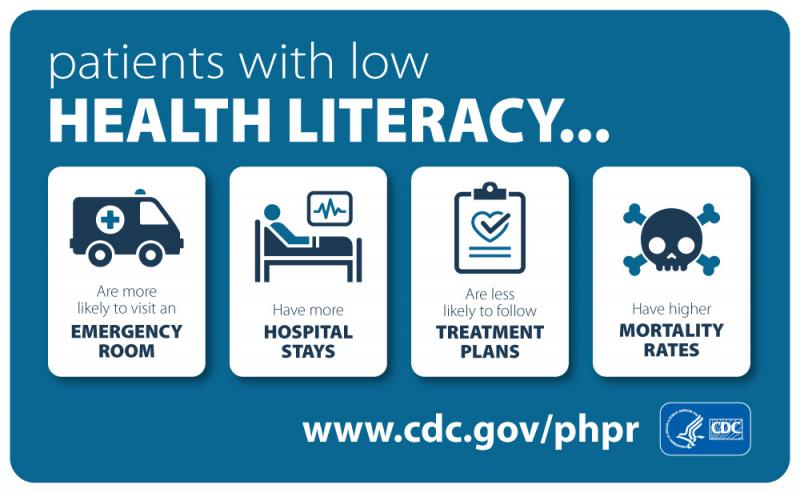
I am aware of the privilege in society around being born in the United States, speaking english, and having experience in the medical field. However, even for someone with these opportunities navigating the healthcare system can be a daunting process.. Each visit to a doctor is accompanied with medical and legal jargon, regarding insurance coverage and diagnoses that are often over my head. Yet, in the United States healthcare system, patients are expected to have a general understanding of medical terminology and terms such as'blood pressure" and'antibiotic side effects" that are thrown around by healthcare professionals without explanation. This environment contributes to the problem of health literacy in the United States, which greatly impacts access to services and creates inequalities in, healthcare.
Health Literacy has been defined by the U.S. Department of Health and Human Services to mean'the degree to which individuals have the capacity to obtain, process, and understand basic health information and services needed to make appropriate health decisions." Within the healthcare system there are two parties responsible for disseminating health information (and improving health literacy): (1) providers, and (2) patients. Yet, somehow, the majority of responsibility in understanding medical terms, the diagnoses they describe, and the potential ramifications, lies with the patients, not the providers. Patients are responsible for navigating the healthcare system, and medical terminology, while mostly relying on their quick visit with a medical provider and a Google search bar.
To further exemplify the importance of health literacy in the United States, the Center for Disease Control (CDC) has provided the following facts:
1. Nine out of 10 adults struggle to understand and use health information when it is unfamiliar, complex or jargon-filled.
2. Limited health literacy costs the healthcare system money and results in higher than necessary morbidity and mortality.
3. Health literacy can be improved if we practice clear communication strategies and techniques.
4. Clear communication means using familiar concepts, words, numbers and images presented in ways that make sense to the people who need the information.
5. Testing information with the audience before it is released and asking for feedback are the best ways to know if we are communicating clearly. We need to test and ask for feedback every time information is released to the general public.
As a patient navigator at the Illinois Eye Institute at Princeton Clinic, I have the opportunity to to help provide effective communication around health information to patients (and their parents). I have found this to be the most challenging aspect of my service year because of language barriers and my struggle to convey medical jargon in a way that the parents understand. Of course, in communicating the patient's diagnosis, there is a fine line between scaring the parent and fully conveying the severity of the situation. Often times, parents are not aware of what the diagnosis means. Some of the optometrists from the mobile clinics (where the patient would have first received care) are very thorough in explaining the diagnosis through non-medical jargon, and seem to comprehend the importance of health literacy for their patients. For example, if the provider is capable of fully explaining what the words'glaucoma" or'conjunctivitis" are, the parent will understand the diagnosis better. However, because some medical providers have illegible handwriting or fail to provide explanations as to what'amaurosis fugax" or'pseudopapilledema" mean, the parents may understandably be left confused. When this occurs, I rely on the optometrists I work with to explain each diagnosis to me so that I can properly describe the diagnosis in clear language to each parent.
While health literacy is a significant problem in the United States, I am fully committed to my role in improving health literacy for my patients. Thankfully, with the help of the optometrists at Illinois Eye Institute at Princeton Clinic I am able to stay committed to this cause while providing the best patient care possible.

This blog post was written by 2018-19 NHC Chicago member Kerri Goldstein.
Kerri is a Patient Navigator at Illinois Eye Institute at Princeton Vision Clinic.
